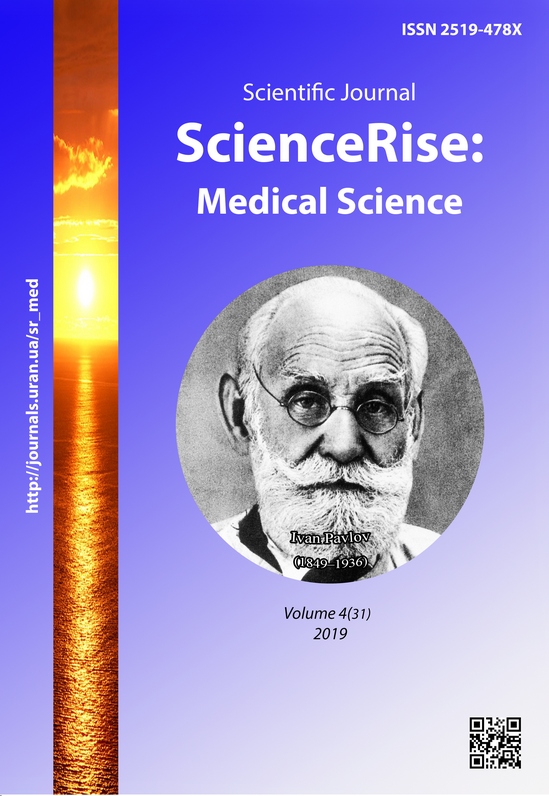Vertical movement of dystopic canines using deviсe with Nd-Fe-B magnets (clinical case)
DOI:
https://doi.org/10.15587/2519-4798.2019.173921Keywords:
malocclusions, canine dystopia, teeth position correction, Nd-Fe-B magnets, devices with magnetsAbstract
The use of braces for the correction of single tooth position in some cases seems to be impractical, since it may cause a violation in the position of the adjacent teeth, which are used as a support for such correction. An alternative way to move of single tooth into the normal position is use of device with permanent Nd-Fe-B magnets. This allows to localize the force action and achieve the desired aesthetic and functional result with fewer side effects and also reduce the cost of treatment.
The aim of present work was development of methods and normalization of position of upper jaw canine by using the device with permanent Nd-Fe-B magnets.
Materials and methods. To move the tooth, the permanent Nd-Fe-B magnets of size 5×5×2 mm were used. An anti-corrosion ZrO2 coating was applied to the surface of the magnets. One of them was installed in a plastic devise, and the second one was fixed on the tooth using photopolymer material. The magnitude of acting force was determined using the experimentally derived dependence of the force of attraction or repulsion of magnets on the distance between them. Additional control of the interaction forces between the magnets, both at the beginning of treatment and at individual stages, was carried out using a teslameter and recalculation tables.
Results. The article provides a description of the technique and stages of manufacturing of device with magnets, as well as the procedure for attaching the magnet to the tooth surface. There was presented a clinical case of moving an abnormally located canine using a device with permanent Nd-Fe-B magnets. As a result of orthodontic treatment performed using a permanent magnet device, a vestibular displacement of the tooth 23 was performed in order to achieve normal overlap in the transverse plane. The proposed method of orthodontic treatment allowed in a short time to normalize the position of tooth 23 without side effects for the remaining teeth.
Conclusions. On the base of treatment it was proved the possibility of moving individual tooth using the device with Nd-Fe-B permanent magnets without the occurrence of side effects for supporting teeth, which allows expanding the range of traditional bite correction methods
References
- Bariani, R. B., Guimarães, C., Moura, W., Ortolani, C. F., Henriques, J. C., Pereira-Bellini, S. (2018). Treatment of class II malocclusion and unerupted upper canines with self-ligating appliance. Indian Journal of Dental Research, 29 (3), 391–395. doi: http://doi.org/10.4103/ijdr.ijdr_231_15
- Burstone, C. J., Koenig, H. A. (1974). Force systems from an ideal arch. American Journal of Orthodontics, 65 (3), 270–289. doi: http://doi.org/10.1016/s0002-9416(74)90332-7
- Li, L. C. F., Wong, R. W. K., King, N. M. (2008). Orthodontic traction of impacted canine using magnet: a case report. Cases Journal, 1 (1), 382. doi: http://doi.org/10.1186/1757-1626-1-382
- Tomizuka, R., Kanetaka, H., Shimizu, Y., Suzuki, A., Igarashi, K., Mitani, H. (2006). Effects of Gradually Increasing Force Generated by Permanent Rare Earth Magnets for Orthodontic Tooth Movement. The Angle Orthodontist, 76 (6), 1004–1009. doi: http://doi.org/10.2319/071805-237
- Sharma, N. S., Kamble, R., Shrivastav, S., Sharma, P. (2015). The Use of Magnets in Orthodontics. World Journal of Dentistry, 6 (1), 45–48. doi: http://doi.org/10.5005/jp-journals-10015-1311
- Phelan, A., Tarraf, N. E., Taylor, P., Hönscheid, R., Drescher, D., Baccetti, T., Darendeliler, M. A. (2012). Skeletal and dental outcomes of a new magnetic functional appliance, the Sydney Magnoglide, in Class II correction. American Journal of Orthodontics and Dentofacial Orthopedics, 141 (6), 759–772. doi: http://doi.org/10.1016/j.ajodo.2012.01.014
- Kutsevliak, V. Y., Starykov, V. V. (2018). Snyzhenye elektrokhymycheskoi aktyvnosty postoiannikh mahnytov, prymeniaemikh v ortodontycheskykh apparatakh. Visnyk stomatolohii, 3, 32–35.
- Kitsugi, A., Okuno, O., Nakano, T., Hamanaka, H., Kuroda, T. (1992). The Corrosion Behavior of Nd2Fe14B and SmCo5 Magnets. Dental Materials Journal, 11 (2), 119–129. doi: http://doi.org/10.4012/dmj.11.119
- Kutsevliak, V. Y., Starykov, V. V. (2018). Otsenka syli vzaymodeistvyia Nd-Fe-B postoiannikh mahnytov, prymeniaemikh v ortodontycheskykh apparatakh. Ukrainskyi zhurnal medytsyny, biolohii ta sportu, 7, 191–196.
- Darendeliler, M. A., Darendeliler, A., Mandurino, M. (1997). Clinical application of magnets in orthodontics and biological implications: a review. The European Journal of Orthodontics, 19 (4), 431–442. doi: http://doi.org/10.1093/ejo/19.4.431
Downloads
Published
How to Cite
Issue
Section
License
Copyright (c) 2019 Valerii Kutsevliak, Vladyslav Starikov

This work is licensed under a Creative Commons Attribution 4.0 International License.
Our journal abides by the Creative Commons CC BY copyright rights and permissions for open access journals.
Authors, who are published in this journal, agree to the following conditions:
1. The authors reserve the right to authorship of the work and pass the first publication right of this work to the journal under the terms of a Creative Commons CC BY, which allows others to freely distribute the published research with the obligatory reference to the authors of the original work and the first publication of the work in this journal.
2. The authors have the right to conclude separate supplement agreements that relate to non-exclusive work distribution in the form in which it has been published by the journal (for example, to upload the work to the online storage of the journal or publish it as part of a monograph), provided that the reference to the first publication of the work in this journal is included.









